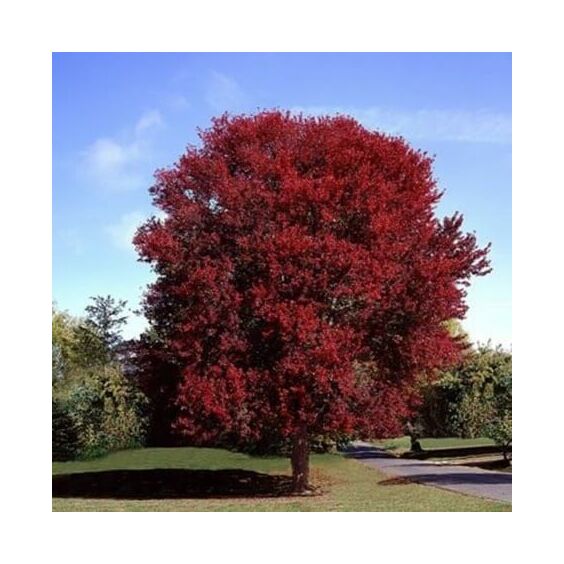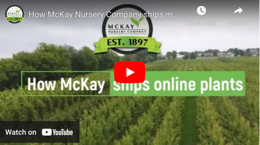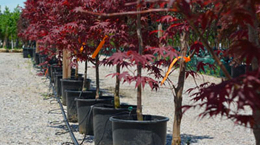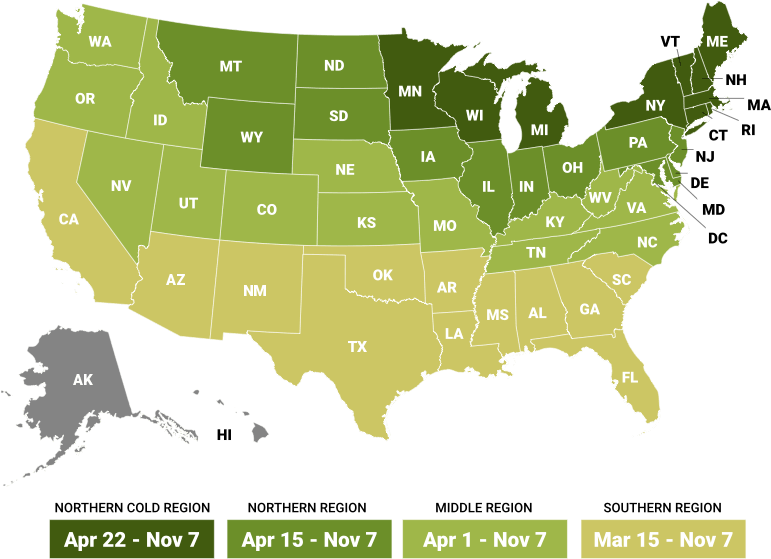
Growing zones
See Zone Map >Status: Out of stock
Mature Plant Size (H x W): 40-45' x 40-45'
- Attracts Bees
- Attracts Birds
- Walnut Toxicity Resistant
- Attracts Pollinators
Planting & Care for Trees – Burgundy Belle® Maple Trees
Preparation
- Red maples are known for their beautiful red color through all the various seasons. They have red flowers in spring, leafstalks in summer, brilliant red foliage in fall and red buds in winter.
- Red maple trees are commonly used for their ornamental value in the landscape.
- Can grow in an oval, rounded, upright or erect shape.
- Can be toxic to horses if dry, wilted leaves are consumed.
- It is also the state tree of Rhode Island.
- This tree needs full sun in order to see the best color results and longevity.
- The red maple grows in acidic, loamy, moist, rich, sandy, silty loam, well-drained and clay soils. It prefers wet soil conditions but has slight drought tolerance.
- Adding a 3-inch layer of mulch helps the soil retain moisture and inhibits the growth of weeds. Pull the mulch back a few inches from the trunk to prevent rot.
Opening Plant Material
- B&B - Soak root ball very well.
- Each type of plant has an illustration on how to plant if you scroll down and click on the orange rectangular box “Handling & Plant Guidelines”.
Planting B&B trees
- Plant B&B trees in spring or fall. A good indicator if you can still plant is if the ground is still workable you’re good to go. If a hard frost is expected be sure to hold off on planting.
- Dig a hole at least 6" wider and no deeper than the size of the ball on the plant. Rotate the plant to the proper position. Never lift or move trees by the tops.
- Notice where the base of the trunk flairs out from the tree. This is called the root flair. This root flair should show when the tree is planted. If necessary, add soil under the ball so the root flair is exposed.
- Place fertilizer packets into the bottom of the hole (if purchased). *Use Our Recommended Fertilizer
- Backfill ½ of the hole with soil and completely saturate the soil with water.
- Once the tree is straight and located as desired, cut and remove twine. Then, remove or bend back top ? of metal basket. Lastly, remove exposed burlap from top of ball
- Fill the hole to the top of the ball with soil, then soak well with water and let settle.
- The top of the root ball should be visible and slightly higher than the soil around it.
- Add mulch on top of soil making sure to not put mulch against the trunk or stems.
- See our link below “Handling & Planting Guidelines” for illustrations on planting.
Pruning - After Planting
- B&B - Although it is not essential for B&B to be pruned after planting, a light pruning for shape, to remove any broken branches from shipping, or to thin out a heavily branched plant will help in the transplanting process and in the appearance of your new planting.
Pruning - Through-out the Season
- Corrective pruning to remove dead, dying, and diseased branches should be done in winter.
- Prune branches that grow into the center or rub against each other. Remove smaller branches up to two inches in diameter first. Sugar maple makes dense shade; removal of some branches in the center will let in sun and air. Cut small branches just outside the "collar", the thick fold of bark at the junction of the branch and its lateral. Cutting "flush" to the main branch injures the collar and cutting too far out leaves a "stub", both lengthening the healing time for the tree.
Watering - After Planting
- Plants typically take approximately 6 weeks to establish new roots in your soil. During this period, water plants as often as every 2-4 days at the start and at least a minimum of once per week.
- Beyond the 6 week establishment period, water once per week, unless rains occur.
- Stick your finger into the soil around 3” to check soil moisture.
Watering - Through-out the Season
- After the first season, plants should only be watered during extended periods without rain.
- How do you know if your plants need water? The easiest way to tell is to touch the soil around the roots. If it is moist, there is no need to water. If it is dry, give it a good soaking with the hose end (no nozzle) watering the soil only, not the leaves.
- Stick your finger into the soil around 3” to check soil moisture.
Planting & Handling Help
Download our Planting and Handling Guide below to plan for a successful arrival and install of your plants. Be sure to water all plants as soon as they arrive and every day until you’re ready to plant. Keep any bare root bundles in a shady, cool spot with the roots covered at all times.


Learn More
Watch our videos on handling bare root plants, how your order is prepared for shipment and more.


Plant Sizing
What is the difference between Containers, Grow Bags, Bare Root, and Balled & Burlap (B&B)?
Shipping Times


Our FedEx and local shipping times depend on two factors, one is by the region and the second is the type of product being shipped. For example, small fruits are only shipped in spring, but majority of our perennials are shipped from spring until fall. Keep in mind the dates below act as a general guide. Due to unpredictable weather, staffing, inventory and industry demands these timelines can change. Therefore, we cannot guarantee any of these times.
Shipping Dates by Region*
Northern Cold Region: April 22nd - November 7th
Northern Region: April 15th - November 7th
Middle Region: April 1st - November 7th
Southern Region: March 15th - November 7th
Local Delivery (small radius from Waterloo, WI): April 22nd - November 7th
Shipping Dates by Season*
Spring Shipping: Region Start Date (above) - May
Fall Shipping: September - November
Due to unpredictable weather, these times may vary. Some varieties are exceptions due to heat and plant health reasons. Enter your shipping zip code at the top of this page and be sure to check the shipping information on each product before you add it to your cart. If the product is too large or restricted in your state, you will not be able to checkout with that item in your cart.
